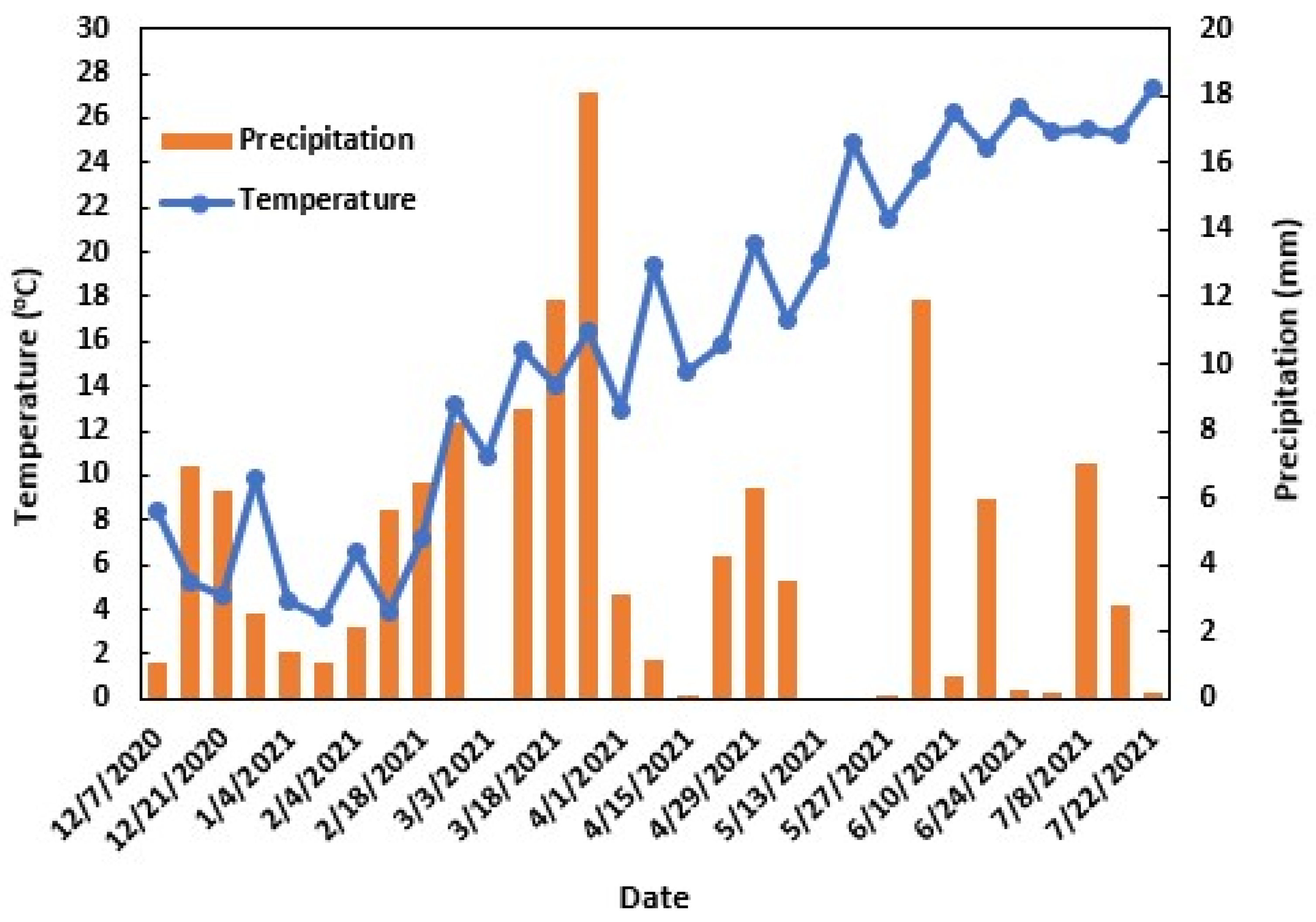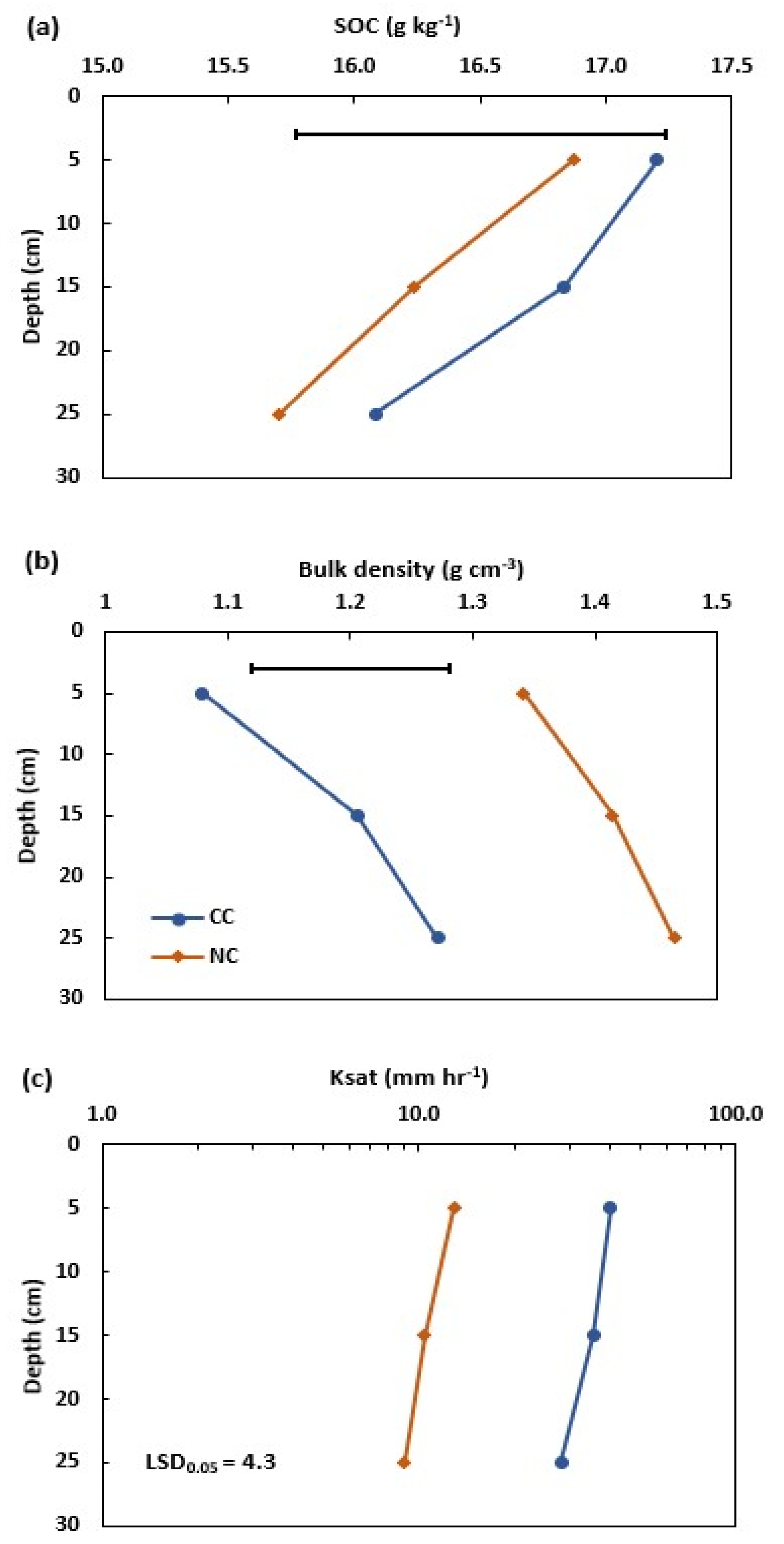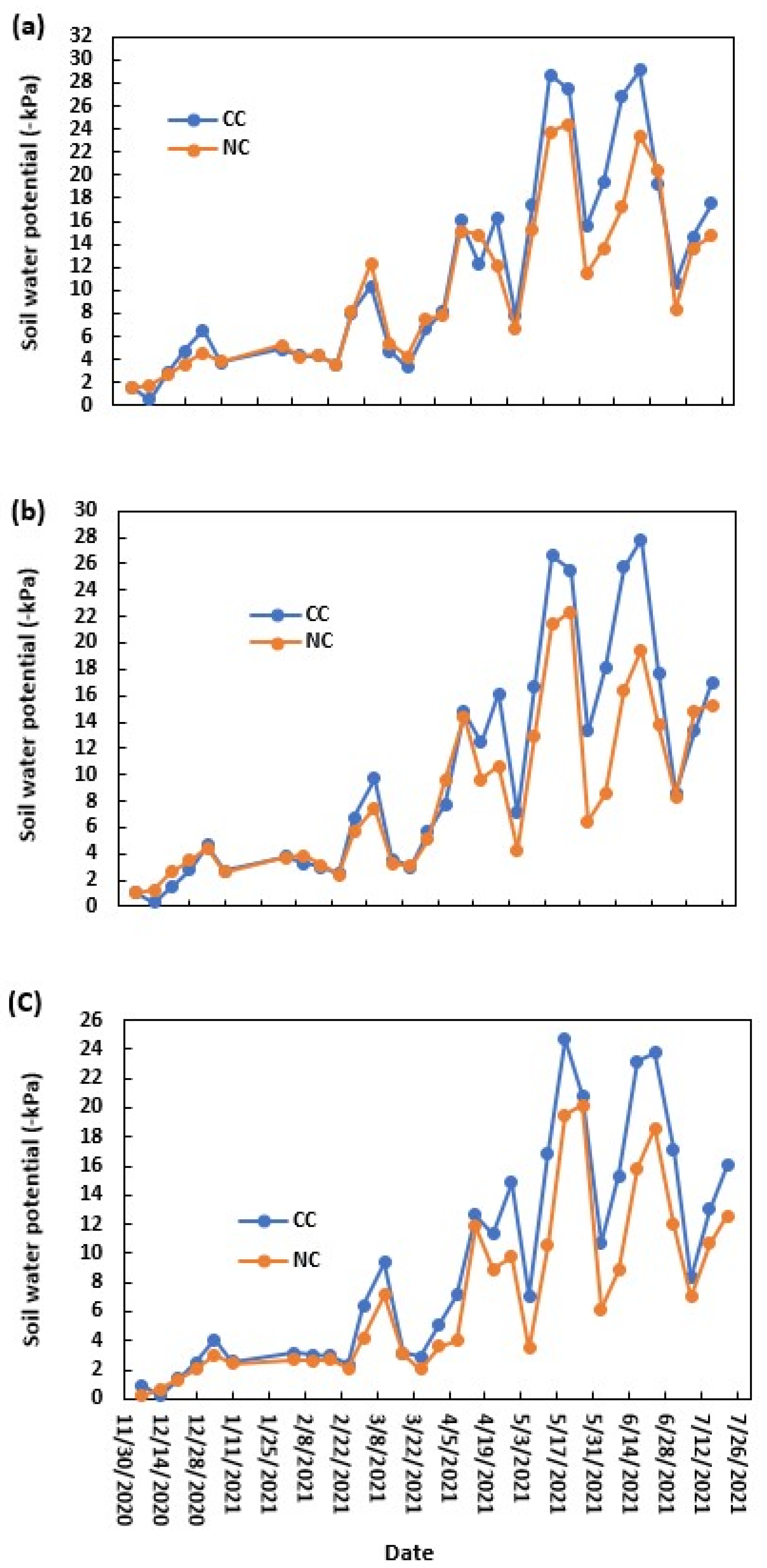Do Cover Crops Influence In Situ Soil Water Potential After Termination?
Abstract
:1. Introduction
2. Materials and Methods
2.1. Site Description
2.2. Management Description
2.3. Sensor Installation, Soil Sampling, and Analysis
2.4. Statistical Analysis
3. Results and Discussions
3.1. Soil Organic Carbon, Bulk Density, and Saturated Hydraulic Conductivity
3.2. In Situ Soil Water Potential
4. Conclusions
Supplementary Materials
Author Contributions
Funding
Data Availability Statement
Acknowledgments
Conflicts of Interest
Abbreviations
References
- Salem, H.M.; Valero, C.; Muñoz, M.A.; Rodríguez, M.G.; Silva, L.L. Short-term effects of four tillage practices on soil physical properties, soil water potential, and maize yield. Geoderma 2015, 237–238, 60–70. [Google Scholar] [CrossRef]
- Aslyng, H.C. Soil physics terminology. Int. Soc. Soil Sci. Bull. 1963, 23, 321. [Google Scholar]
- Tuller, M.; Or, D. Water Retention and Characteristic Curve. Encycl. Soils Environ. 2004, 4, 17–26. [Google Scholar] [CrossRef]
- Jama, A.O.; Ottman, M.J. Timing of the first irrigation in corn and water stress conditioning. Agron. J. 1993, 85, 1159–1164. [Google Scholar] [CrossRef]
- Calviño, P.A.; Andrade, F.H.; Sadras, V.O. Maize yield as affected by water availability, soil depth, and crop management. Agron. J. 2003, 95, 275–281. [Google Scholar] [CrossRef]
- Araya, A.; Stroosnijder, L.; Girmay, G.; Keesstra, S.D. Crop coefficient, yield response to water stress and water productivity of teff (Eragrostis tef (Zucc.)). Ag. Wat. Manag. 2011, 98, 775–783. [Google Scholar] [CrossRef]
- Osakabe, Y.; Osakabe, K.; Shinozaki, K.; Tran, L.S.P. Response of plants to water stress. Front. Plant Sci. 2014, 5, 86. [Google Scholar] [CrossRef]
- Moshelion, M.; Halperin, O.; Wallach, R.; Oren, R.A.M.; Way, D.A. Role of aquaporins in determining transpiration and photosynthesis in water-stressed plants: Crop water-use efficiency, growth and yield. Plant Cell Environ. 2015, 38, 1785–1793. [Google Scholar] [CrossRef]
- Or, D.; Wraith, J.M. Soil water content and water potential relationships. In Soil Physics Companion; Warrick, A.W., Ed.; CRC Press: Boca Raton, FL, USA, 2002; pp. 49–84. [Google Scholar]
- Yang, H.; Feng, J.; Zhai, S.; Dai, Y.; Xu, M.; Wu, J.; Shen, M.; Bian, X.; Koide, R.T.; Liu, J. Long-term ditch-buried straw return alters soil water potential, temperature, and microbial communities in a rice-wheat rotation system. Soil Till. Res. 2016, 163, 21–31. [Google Scholar] [CrossRef]
- Dabney, S.M.; Delgado, J.A.; Reeves, D.W. Using winter cover crops to improve soil and water quality. Commun. Soil Sci. Plant Anal. 2001, 32, 1221–1250. [Google Scholar] [CrossRef]
- Haruna, S.I.; Anderson, S.H.; Udawatta, R.P.; Gantzer, C.J.; Phillips, N.C.; Cui, S.; Gao, Y. Improving soil physical properties through the use of cover crops: A review. Agrosyst. Geosci. Environ. 2020, 3, e20105. [Google Scholar] [CrossRef]
- Basche, A.D.; Kaspar, T.C.; Archontoulis, S.V.; Jaynes, D.B.; Sauer, T.J.; Parkin, T.B.; Miguez, F.E. Soil water improvements with the long-term use of a winter rye cover crop. Agri. Wat. Manag. 2016, 172, 40–50. [Google Scholar] [CrossRef]
- Gabriel, J.L.; García-González, I.; Quemada, M.; Martin-Lammerding, D.; Alonso-Ayuso, M.; Hontoria, C. Cover crops reduce soil resistance to penetration by preserving soil surface water content. Geoderma 2021, 386, 114911. [Google Scholar] [CrossRef]
- Steenwerth, K.; Belina, K.M. Cover crops enhance soil organic matter, carbon dynamics and microbiological function in a vineyard agroecosystem. Appl. Soil Ecol. 2008, 40, 359–369. [Google Scholar] [CrossRef]
- Bilek, M. Winter Annual Rye Cover Crops in No-Till Grain Crop Rotations: Impacts on Soil Physical Properties and Organic Matter. Master’s Thesis, University of Maryland, College Park, MD, USA, 2007. Available online: https://www.proquest.com/docview/304852060?pq-origsite=gscholar&fromopenview=true&sourcetype=Dissertations%20&%20Theses (accessed on 25 September 2024).
- Rorick, J.D.; Kladivko, E.J. Cereal rye cover crop effects on soil carbon and physical properties in southeastern Indiana. J. Soil Wat. Conserv. 2017, 72, 260–265. [Google Scholar] [CrossRef]
- Villamil, M.B.; Bollero, G.A.; Darmody, R.G.; Simons, F.W.; Bullock, D.G. No-till corn/soybean systems including winter cover crops. Soil Sci. Soc. Am. J. 2006, 70, 1936–1944. [Google Scholar] [CrossRef]
- Liesch, A.M.; Krueger, E.S.; Ochsner, T.E. Soil structure and physical properties under rye-corn silage double-cropping systems. Soil Sci. Soc. Am. J. 2011, 75, 1307–1314. [Google Scholar] [CrossRef]
- Drury, C.F.; Tan, C.S.; Welacky, T.W.; Reynolds, W.D.; Zhang, T.Q.; Oloya, T.O.; McLaughlin, N.B.; Gaynor, J.D. Reducing nitrate loss in tile drainage water with cover crops and water-table management systems. J. Environ. Qual. 2014, 43, 587–598. [Google Scholar] [CrossRef]
- Haruna, S.I.; Anderson, S.H.; Nkongolo, N.V.; Zaibon, S. Soil hydraulic properties: Influence of tillage and cover crops. Pedosphere 2018, 28, 430–442. [Google Scholar] [CrossRef]
- Haruna, S.I.; Ward, Z.A.; Cartwright, A.L.; Wunner, A.A.; Jackson, C.A.; Berry, C.R. No-till cover crop effects on the thermal properties of a Paleudult. Soil Till. Res. 2023, 231, 105717. [Google Scholar] [CrossRef]
- Eldredge, E.P.; Shock, C.C.; Steiber, T.D. Calibration of granular matrix sensors for irrigation management. Agron. J. 1993, 85, 1228–1232. [Google Scholar] [CrossRef]
- Allen, R.G. Calibration of the Watermark 200SS Soil Wáter Potential Sensor to Fit the 7-19-96 “Calibration #3” Table from Irrometer; University of Idaho: Kimberly, ID, USA, 2000. [Google Scholar]
- Thompson, S.J.; Fisher, D.K.; Sassenrath-Cole, G.F. Use of granular-matrix sensors, models, and evaporation measuring devices for monitoring cotton water use and soil water status in the Mississippi Delta. In Proceedings of the 2002 Beltwide Cotton Conference; National Cotton Council, Memphis, TN, USA, 8–12 January 2002; pp. 623–637. [Google Scholar]
- Shock, C.C.; Barnum, J.M.; Seddigh, M. Calibration of Watermark Soil Moisture Sensors for Irrigation Management; Oregon State University: Corvallis, OR, USA, 1998; Available online: https://www.researchgate.net/profile/Clinton-Shock/publication/228762944_Calibration_of_W_ermark_Soil_Moisture_Sensors_for_Irrigation_Management/links/55ed971408ae3e12184819e7/Calibration-of-W-ermark-Soil-Moisture-Sensors-for-Irrigation-Management.pdf (accessed on 25 September 2024).
- Reynolds, W.D.; Elrick, D.E. Constant head soil core (tank) method. Laboratory method. In Methods of Soil Analysis, Part 4-Physical Methods; Dan, J.H., Topp, G.C., Eds.; Soil Science Society of America: Madison, WI, USA, 2002; Volume 5, pp. 804–808. [Google Scholar]
- Grossman, R.B.; Reinsch, T.G. Bulk density and linear extensibility. In Methods of Soil Analysis, Part 4-Physical Methods; Dane, J.H., Topp, G.C., Eds.; Soil Science Society of America: Madison, WI, USA, 2002; Volume 5, pp. 201–228. [Google Scholar]
- Gee, G.W.; Or, D. Particle size analysis. In Methods of Soil Analysis, Part 4: Physical Methods; SSSA Book Series 5; Dane, J.H., Topp, G.C., Eds.; Soil Science Society of America: Madison, WI, USA, 2002; pp. 255–293. [Google Scholar]
- Vymazal, J.; Sochacki, A.; Fučík, P.; Šereš, M.; Kaplická, M.; Hnátková, T.; Chen, Z. Constructed wetlands with subsurface flow for nitrogen removal from tile drainage. Ecol. Eng. 2020, 155, 105943. [Google Scholar] [CrossRef]
- SAS Institute. Base SAS 9.4 Procedures Guide; SAS Institute: Carey, NC, USA, 2015. [Google Scholar]
- Haruna, S.I.; Eichas, R.C.; Peters, O.M.; Farmer, A.C.; Lackey, D.Q.; Nichols, J.E.; Peterson, W.H.; Slone, N.A. In situ water infiltration: Influence of cover crops after growth termination. Soil Sci. Soc. Am. J. 2022, 86, 769–780. [Google Scholar] [CrossRef]
- Zaibon, S.; Anderson, S.H.; Kitchen, N.R.; Haruna, S.I. Hydraulic properties affected by topsoil thickness in switchgrass and corn–soybean cropping systems. Soil Sci. Soc. Am. J. 2016, 80, 1365–1376. [Google Scholar] [CrossRef]
- Ilek, A.; Kucza, J.; Szostek, M. The effect of the bulk density and the decomposition index of organic matter on the water storage capacity of the surface layers of forest soils. Geoderma 2017, 285, 27–34. [Google Scholar] [CrossRef]
- Tisdall, J.M. Formation of soil aggregates and accumulation of soil organic matter. In Structure and Organic Matter Storage in Agricultural Soils; CRC Press: Boca Raton, FL, USA, 2020; pp. 57–96. [Google Scholar]
- Emerson, W.W.; McGarry, D. Organic carbon and soil porosity. Soil Res. 2003, 41, 107–118. [Google Scholar] [CrossRef]
- Mooney, S.J. Three-dimensional visualization and quantification of soil macroporosity and water flow patterns using computed tomography. Soil Use. Manag. 2002, 18, 142–151. [Google Scholar] [CrossRef]
- Arıkan, Ş.; İpek, M.; Pırlak, L.; Eşitken, A. Physiological and molecular mechanisms in improving salinity stress tolerance by beneficial microorganisms in plants. In Microbial Management of Plant Stresses; Woodhead Publishing: Sawston, UK, 2021; pp. 13–43. [Google Scholar]
- Berdanier, A.B.; Klein, J.A. Growing season length and soil moisture interactively constrain high elevation aboveground net primary production. Ecosystems 2011, 14, 963–974. [Google Scholar] [CrossRef]
- Zou, C.; Penfold, C.; Sands, R.; Misra, R.K.; Hudson, I. Effects of soil air-filled porosity, soil matric potential and soil strength on primary root growth of radiata pine seedlings. Plant Soil. 2001, 236, 105–115. [Google Scholar] [CrossRef]
- Rivera-Hernández, B.; Carrillo-Ávila, E.; Obrador-Olán, J.J.; Juárez-López, J.F.; Aceves-Navarro, L.A. Morphological quality of sweet corn (Zea mays L.) ears as response to soil moisture tension and phosphate fertilization in Campeche, Mexico. Agric. Water Manag. 2010, 97, 1365–1374. [Google Scholar] [CrossRef]
- Bodner, G.; Loiskandl, W.; Hartl, W.; Erhart, E.; Sobotik, M. Characterization of cover crop rooting types from integration of rhizobox imaging and root atlas information. Plants 2019, 8, 514. [Google Scholar] [CrossRef] [PubMed]
- Blanco-Canqui, H.; Shaver, T.M.; Lindquist, J.L.; Shapiro, C.A.; Elmore, R.W.; Francis, C.A.; Hergert, G.W. Cover Crops and Ecosystem Services: Insights from Studies in Temperate Soils. Agron. J. 2015, 107, 2449–2474. [Google Scholar] [CrossRef]



| Clay | Silt | Sand | |
|---|---|---|---|
| Depth (cm) | ----------------------------------------%------------------------------------------ | ||
| 0–10 | 14.2 | 22.5 | 63.3 |
| 10–20 | 16.7 | 21.7 | 61.7 |
| 20–30 | 15.8 | 20.8 | 63.3 |
Disclaimer/Publisher’s Note: The statements, opinions and data contained in all publications are solely those of the individual author(s) and contributor(s) and not of MDPI and/or the editor(s). MDPI and/or the editor(s) disclaim responsibility for any injury to people or property resulting from any ideas, methods, instructions or products referred to in the content. |
© 2024 by the authors. Licensee MDPI, Basel, Switzerland. This article is an open access article distributed under the terms and conditions of the Creative Commons Attribution (CC BY) license (https://creativecommons.org/licenses/by/4.0/).
Share and Cite
Peters, O.M.; Haruna, S.I. Do Cover Crops Influence In Situ Soil Water Potential After Termination? Agronomy 2024, 14, 2549. https://doi.org/10.3390/agronomy14112549
Peters OM, Haruna SI. Do Cover Crops Influence In Situ Soil Water Potential After Termination? Agronomy. 2024; 14(11):2549. https://doi.org/10.3390/agronomy14112549
Chicago/Turabian StylePeters, Olivia M., and Samuel I. Haruna. 2024. "Do Cover Crops Influence In Situ Soil Water Potential After Termination?" Agronomy 14, no. 11: 2549. https://doi.org/10.3390/agronomy14112549
APA StylePeters, O. M., & Haruna, S. I. (2024). Do Cover Crops Influence In Situ Soil Water Potential After Termination? Agronomy, 14(11), 2549. https://doi.org/10.3390/agronomy14112549





